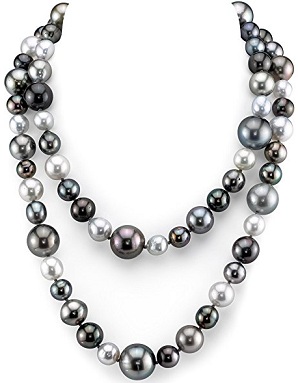Tahitian pearls with their glamorous colors are among the most exotic of all cultured pearls. Though popularly known as ‘Black Tahitian Pearls’, they do come in an array of interesting and mysterious colors. Their inimitable coloring endows these pearls with an irresistible visual appeal. These pearls make delightful gifts appreciated by almost every woman on the planet. They make glorious jewelry accessories adding to the charm of any ensemble.
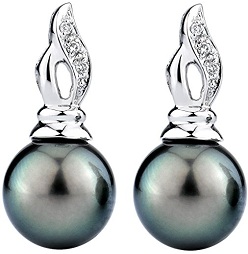 |
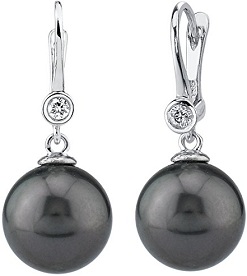 |
|||
| 14K Gold Tahitian South Sea Cultured Pearl and Diamond Wave Earrings | 14K Gold Tahitian South Sea Cultured Pearl & Diamond Michelle Earrings |
Click On The The Images
Their most intriguing attributes are the exotic dark color coupled with the sparkling overtones spread over the primary body color of the pearl. Connoisseurs focus on this color attribute while choosing Tahitian pearls. Aubergines to Aquamarines, Cherries to Silvers, iridescent peacock to cobalt blue and luscious natural Chocolate are some of the gorgeous overtones seen on these pearls. The overtones endow a vibrant brilliancy to their dark body colors. All (or any combination) of these colors might be seen on a Tahitian pearl. Due to the vast range of shapes & colors of the Tahitian pearl, it has been known to fit in any jewelry setting. The versatility & mixture of color gives the pearl its value.
14K Gold 9-15mm Off-Round Tahitian Multicolor South Sea Cultured Pearl Necklace
Click On The Image
In addition, the pearls sport a brilliant mirror like luster. Consequently, Tahitian pearls are highly coveted by pearl lovers of the world. Iridescent peacock and cobalt blue colors command the highest premium. Rainbow, gold & gray overtones are also greatly admired.
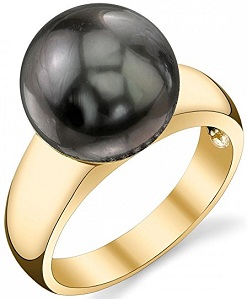 |
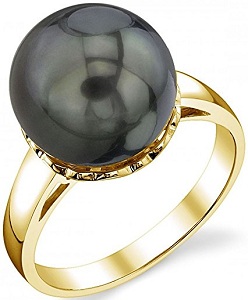 |
|||
| 10mm Tahitian South Sea Cultured Pearl Abigail Ring in 14K Gold | 11mm Tahitian South Sea Cultured Pearl Laurel Ring in 14K Gold |
Click On The The Images
A truly and completely black Tahitian pearl is exceptionally rare. It is a beautiful pearl and a treasure to be cherished. A good number of Tahitian pearls identified as ‘black’ are in reality charcoal-grey, silver-grey or very dark green.
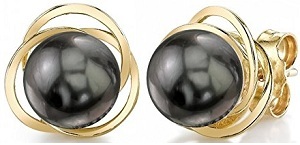 |
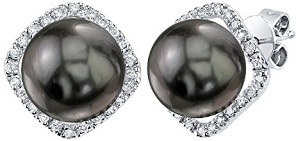 |
|
| 14K Gold Tahitian South Sea Cultured Pearl Lexi Earrings | 14K Gold Tahitian South Sea Cultured Pearl & Diamond Ella Earrings |
Click On The The Images
Another attribute that make these pearls so desirable is their large size. Tahitian pearls are among the largest pearls in the world. Their sizes range from 8 mm to 18 mm. In fact, these pearls rival South-sea pearls (considered to be the largest pearls of all) in size. Tahitian pearls are cultivated inside the shells of the Pinctada Margaritifera oyster. The oyster can grow to the size of one foot or more in diameter and weigh as much as ten pounds. As such, they produce very large pearls. Also, the organism is very sensitive to the marine environment making the pearl difficult to produce and hence very rare and valuable.
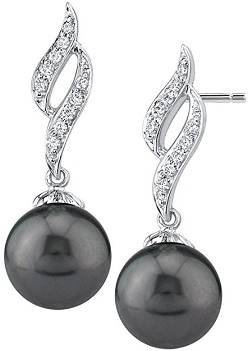 |
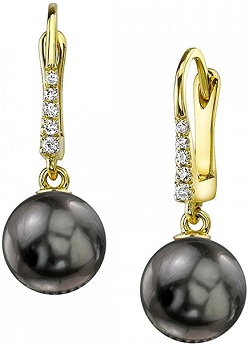 |
|||
| 14K Gold Tahitian South Sea Cultured Pearl & Diamond Suzanna Earrings | 14K Gold Tahitian South Sea Cultured Pearl & Diamond Susan Earrings |
Click On The The Images
The black lip pearl oyster has a rainbow-like mantle which displays virtually all colors of the visible spectrum. The colors are imparted to the Tahitian pearls as overtones and shimmer like magic over the surface of some of the best hand-picked specimens.
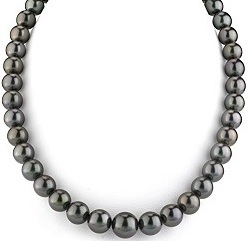 |
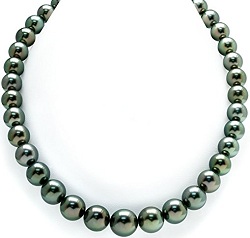 |
|||
| 14K Gold GLA CERTIFIED Black Tahitian South Sea Cultured Pearl Necklace | 14K Gold 10-12mm Peacock Tahitian South Sea Cultured Pearl Necklace |
Click On The The Images
The Pinctada Margaritifera oyster is found exclusively in the sea waters around French Polynesian islands near Tahiti. It is obvious that the name of the pearl stems from the name of the island. Even though these pearls take the name of the well-known island they actually do not come from Tahiti. Rather, Tahiti is the main trading post for the chain of surrounding islands that produce Tahitian pearls.
Tahitian pearls are bead nucleated for culturing. Because of this, a good number of them turn out to be round or near round. Other attributes being similar, round Tahitian pearls command the highest prices. More shapes that occur are drops, baroques, semi-baroques, button & circled pearls.
A skilled grafter inserts a bead made from a mollusk shell into the gonad of the mature Pinctada margaritifera mollusk. He also inserts a piece of mantle tissue from a donor mollusk along with the bead. The color of this tissue influences the color and overtone of resulting pearl. It also triggers the secretion of nacre by the hosting mollusk.
These pearls are bead nucleated like akoya pearls. But unlike akoya pearls, Tahitian pearls are coated with thicker layers of nacre. Under French Polynesian laws, minimum prescribed thickness of nacre for export quality pearls is 0.8 mm. (The same thickness is considered exceptionally thick in case of Akoya pearls). In order to impose this quality standard, random x-ray checks are conducted at the Ministry of Tahitian Perliculture before export. If thinner than prescribed nacre pearls are found, they are destroyed & the nuclei are recycled.
Luster is a property of the nacre and Tahitian pearls can display luster of metallic intensity with well-detailed reflections & well-defined crisp squares of reflected light on their surfaces.
However, very few Tahitian pearls are deemed truly flawless. The imperfections can be on account of different reasons. But mostly they arise from the sand particles inside the shell during pearl formation. Sand is the omnipresent entity all during the process. A shell can rarely escape the sand granules. Also, water currents and body movement of the mollusk can cause imperfections. In fact, the imperfections are a mark authenticity and a completely flawless pearl can also make it suspect of being an artificial one.
Tahitian pearls are among the most sought-after and expensive pearls in the world.
See Also:
Pearls
| Pearls | Baroque Pearls |
| Akoya Pearls | South Sea Pearls |
| Tahitian Pearls |
